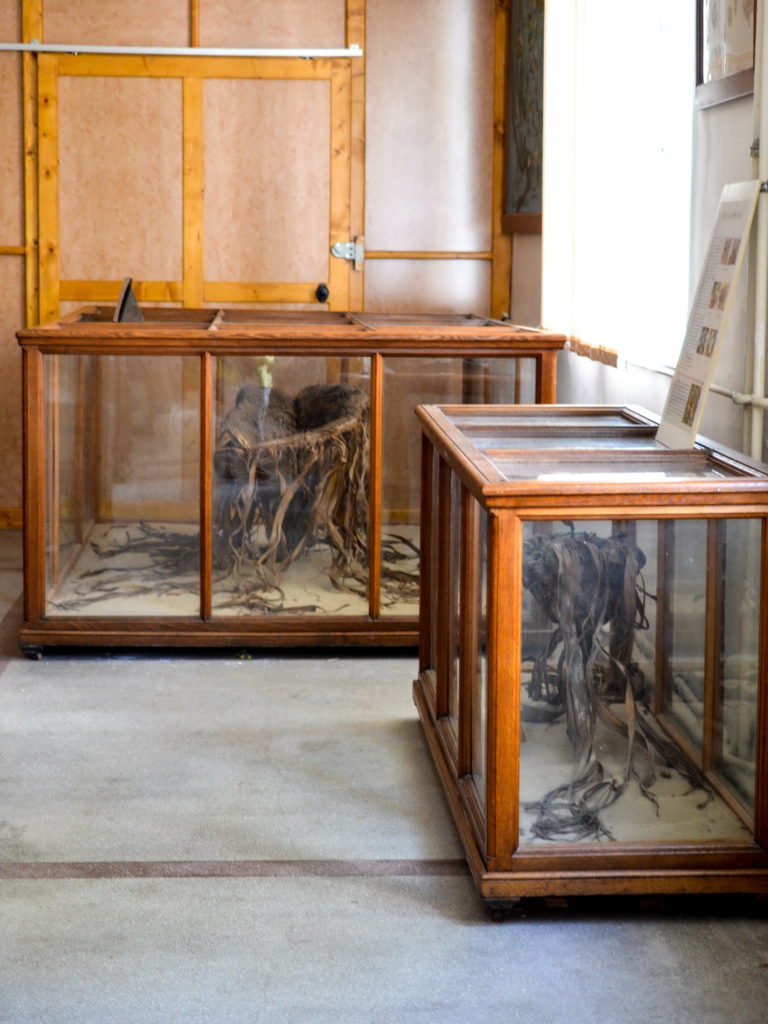The Botanic Museum

Among its 7,000 items displayed, the Botanic Museum offers its visitors the chance to enrich their knowledge of the richness, evolution, and importance of the world of plants. It is housed as a permanent exhibition on the ground floor of the Botanic Institute. The exhibits displayed in the museum, which are preserved either dry (pressed or moulded) or wet (in various preservatives), is done by the following criteria: systematic, ecological, and economic.
Useful plants are represented by food-grade plants, plants providing raw materials for heating and lighting, medicinal and textile plants. A valuable collection is a dendrological collection. It contains around 450 samples of cross-sections, both indigenous woody species (the yew, fir, maple, juniper, cherry, smoke tree, walnut, larch, etc.) and exotic species (the coconut, blue gum tree, ebony, carob tree, cedar, camphor tree, etc.). A special showcase exhibits manufacturing products made in the households of peasants from Țara Moților (wooden pails, large two-handled tubs, alpenhorns, etc.), a typical household from the Câmpulung Moldovenesc area, along with other products obtained by wood processing: writing paper (from the leaves of Borassus flabellifer, the doub palm), rubber from the Pará rubber tree (Hevea brasiliensis), and other species. Another series of showcases feature abnormal growths caused by viruses, fungi, insects, or even plants (the so-called teratological cases) attacking trunks, branches, flowers or fruits. The collection of xylotomic sections (ultra-thin sections cut using specialized instruments) is also impressive, through various wood species such as the hazelnut, cornelian cherry, coffee plant, hornbeam, guelder-rose, elm, etc., which gives a very clear and accurate image of their anatomy and structure.

In the systematic section of the museum, species are displayed in a phylogenetic order according to the evolution of the Plant Kingdom. Besides plants (moss, ferns, gymnosperms, and angiosperms), curiosities from the world of bacteria, algae, mushrooms or lichens are exhibited to visitors. The presentation of plants is complemented by the revolving display stands and framed displays that showcase aspects related to vegetation and nature protection: vegetation zoning and terracing in Romania, the main botanic reserves in the country and the plants they harbor, endemic and protected plants of the area. Some of the collections in the museum belong to the national cultural heritage:
- the collection of medicinal herbs and pharmaceutical drugs, which is the largest in the country containing more than 800 exhibits;
- the collection of longitudinal and transverse sections of wood;
- the collection of palm fruits and seeds.
To these, other heritage values are added:
Welwitschia mirabilis, two exhibits: male and female, unique in the museums of Europe, brought in 1900 from the Namib desert;

Pliocene flora from Borsec, which is a palaeobotany collection containing impressions of fossil plants discovered during the excavations carried out between 1931-1933 in the Borsec area. Visitors will thus discover that millions of years ago plants that today live only in the Mediterranean or Atlantic regions grew on the territory of Romania: Quercus ilex, Cinnamomum rossmoessleri, Smilax aspera, Buxus sempervirens, etc. This is the most complete collection of fossil plants from the Pliocene epoch in the country.